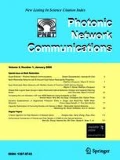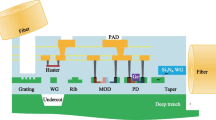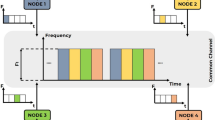Abstract
Hybrid optical-wireless broadband access network (HOWBAN) takes full advantage of the high capacity and reliability of the passive optical network and the flexibility, ubiquity of the wireless network. Similar to other access networks, the issue of high energy consumption is a great challenge for HOWBAN. In HOWBAN, optical network units (ONUs) consume a great amount of energy. The sleep of ONUs can greatly improve the energy efficiency of HOWBAN. However, the quality of service (QoS) will be decreased while the packets are waiting in ONUs and optical line terminal. In this paper, we propose a QoS-aware energy-saving mechanism. A dynamic bandwidth allocation mechanism is designed to guarantee the QoS, where different priorities are considered. Meanwhile, we employ different sleep strategies by taking different priorities’ tolerant delays into account to prolong the sleep time of ONUs. Then, based on the evaluation of packet delay, the optimal sleep parameter is derived to maximum the energy efficiency. In addition, a load balancing and resource allocation mechanism is adopted in the wireless domain to reduce the delay and congestion caused by ONUs’ sleep. Results show that the proposed mechanism can effectively improve the energy efficiency and meet the QoS requirements of packets.








Similar content being viewed by others
References
Zhou, H., Mao, S., Agrawal, P.: Optical power allocation for adaptive transmissions in wavelength-division multiplexing free space optical networks. Digital Commun. Netw. 1(3), 171–180 (2015)
Peng, M., Li, Y., Jiang, J., Li, J., Wang, C.: Heterogeneous cloud radio access networks: a new perspective for enhancing spectral and energy efficiencies. IEEE Wirel. Commun. 21(6), 126–135 (2014)
Luo, C., Guo, S., Guo, S., Yang, L., Min, G., Xie, X.: Green communication in energy renewable wireless mesh networks: routing, rate control, and power allocation. IEEE Trans. Parallel Distrib. Syst. 25(12), 3211–3220 (2014)
Shaddad, R.Q., Mohammad, A.B., Al-Gailani, S.A., Al-Hetar, A.M., Elmagzoub, M.A.: A survey on access technologies for broadband optical and wireless networks. J. Netw. Comput. Appl. 41(5), 459–472 (2014)
Sarigiannidis, A.G., Iloridou, M., Nicopolitidis, P., Papadimitriou, G., Pavlidou, F.N., Sarigiannidis, P.G., Louta, M.D., Vitsas, V.: Architectures and bandwidth allocation schemes for hybrid wireless-optical networks. IEEE Commun. Surv. Tutor. 17(1), 427–468 (2015)
Zhang, Z., Yi, Y., Yang, J., Jing, X.: Energy efficiency based on joint mobile node grouping and data packet fragmentation in short-range communication system. Int. J. Commun. Syst. 27(4), 534–550 (2014)
Wu, D.P., He, J., Wang, H.G., Wang, C.G., Wang, R.Y.: A hierarchical packet forwarding mechanism for energy harvesting wireless sensor networks. IEEE Commun. Mag. 53(8), 92–98 (2015)
Valcarenghi, L., Van, D.P., Raponi, P.G., Castoldi, P., Campelo, D.R., Wong, S., Yen, S., Kazovsky, L.G., Yamashita, S.: Energy efficiency in passive optical networks: where, when, and how. IEEE Netw. 26(6), 61–68 (2012)
Li, Y., Liao, C., Wang, Y., Wang, C.: Energy-efficient optimal relay selection in cooperative cellular networks based on double auction. IEEE Trans. Wirel. Commun. 14(8), 4093–4104 (2015)
Chowdhury, P., Tornatore, M., Sarkar, S., Mukherjee, B.: Building a green wireless-optical broadband access network (WOBAN). J. Lightw. Technol. 28(16), 2219–2229 (2010)
Dhaini, A.R., Ho, P.H., Shen, G.: Toward green next-generation passive optical networks. IEEE Commun. Mag. 49(11), 94–101 (2011)
Kantarci, B., Mouftah, H.T.: Towards energy-efficient hybrid fiber-wireless access networks. In: Proceedings of ICTON, pp. 1–4 (2011)
Schütz, G., Correia, N.: Design of QoS-aware energy-efficient fiber–wireless access networks. J. Opt. Commun. Netw. 4(8), 586–594 (2012)
Liu, X., Ghazisaidi, N., Ivanescu, L., Kang, R.: On the tradeoff between energy saving and QoS support for video delivery in EEE-based FiWi networks using real-world traffic traces. J. Lightw. Technol. 29(18), 2670–2676 (2011)
Shi, L., Mukherjee, B., Lee, S.S.: Energy-efficient PON with sleep-mode ONU: progress, challenges, and solutions. IEEE Netw. 26(2), 36–41 (2012)
Sarkar, S., Yen, H.H., Dixit, S., Mukherjee, B.: A novel delay-aware routing algorithm (DARA) for a hybrid wireless-optical broadband access network (WOBAN). IEEE Netw. 22(3), 20–28 (2008)
Bertsekas, D.P., Gallager, R.G., Humblet, P.: Data Networks. Prentice-Hall, Upper Saddle River (1992)
Hiertz, G.R., Max, S., Zhao, R., Denteneer, D., Berlemann, L.: Principles of IEEE 802.11s. In: Proceedings of International Conference on Computer Communications and Networks, pp. 1002–1007 (2007)
Hiertz, G.R., Denteneer, D., Max, S., Taori, R., Cardona, J., Berlemann, L., Walke, B.: IEEE 802.11s: the WLAN mesh standard. IEEE Wirel. Commun. 17(1), 104–111 (2010)
Acknowledgements
This work is supported in part by the Natural Science Foundation of China (61371097, 61271261), Youth Talents Training Project of Chongqing Science and Technology Commission (CSTC2014KJRC-QNRC40001), Program for Innovation Team Building at Institutions of Higher Education in Chongqing (CXTDX201601020).
Author information
Authors and Affiliations
Corresponding author
Appendix
Appendix
The detailed process of the DGM (1, 1) is as follows:
Step 1 Accumulated generating operation
The sequence of the previous n slots’ average loads for ONU i is expressed as follows:
Making one accumulated generating operation (1-AGO)
where \(x^{\left( 1 \right) }\left( k \right) =\sum \nolimits _{i=1}^k {x^{\left( 0 \right) }} \left( i \right) ,\quad k=1,2,\ldots ,n\).
1-AGO makes any nonnegative, fluctuant and nonfluctuant column translate to nondecreasing and increasing column, which weakens the randomness and strengthens the regularity.
Step 2 Establishment of DGM (1, 1)
The DGM (1, 1) mode is established as follows:
Step 3 Solutions of parameters
Let \(\hat{{\beta }}=\left[ {\beta _1 ,\beta _2 } \right] ^{T}\) be the parameter column, and
Then, we can get
Substituting Y and B into Eq. (37), \(\beta _1 ,\beta _2\) are given by
Step 4 Acquirement of prediction equation
Substituting \(\beta _1 ,\beta _2\) into Eq. (35), then the recurrence function of DGM (1, 1) is obtained as follows
The prediction equation is obtained by inverse 1-AGO as
where \(\hat{{x}}^{\left( 0 \right) }\left( {k+1} \right) \) is the predicted value of ONU i’s average load in the next slot.
Rights and permissions
About this article
Cite this article
Wang, R., Liang, A., Zhou, C. et al. QoS-aware energy-saving mechanism for hybrid optical-wireless broadband access networks. Photon Netw Commun 34, 170–180 (2017). https://doi.org/10.1007/s11107-017-0690-3
Received:
Accepted:
Published:
Issue Date:
DOI: https://doi.org/10.1007/s11107-017-0690-3




